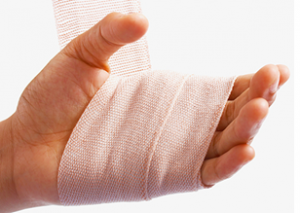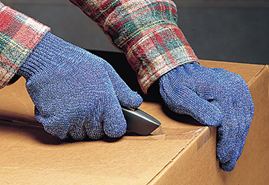The Importance of hand protection
 A hand injury is literally the most common type of injury in the workplace. Hand injuries are even more prominent in the electric, gas, telecommunications construction, and construction industries.
A hand injury is literally the most common type of injury in the workplace. Hand injuries are even more prominent in the electric, gas, telecommunications construction, and construction industries.
In fact, according to a study released in 2013 by the National Safety Council (NSC), injuries to the hands made up 16.5 percent of ALL workplace injuries in 2010. It has also been estimated that the average hand injury will cost around $3700, and that’s not including lost work days or loss in production for the company.
Potential Hazards
Traumatic Injuries
You can suffer a traumatic injury to your hands in many ways:
- Tools and machines with sharp edges can cut your hands.
- Staples, screwdrivers, nails, chisels, and stiff wire can puncture your hands.
- Getting your hands caught in machinery can sprain, crush, or remove your hands and fingers.
Repetitive Motion Injuries
Whenever you repeat the same hand movement over a long period of time, you run the risk of repetitive motion problems. Repetitive motion problems often appear as numbness or tingling sensation accompanied by pain and the loss of gripping power in your hands.
Contact Injuries
Coming into contact with caustic or toxic chemicals, biological substances, electrical sources, or extremely cold or hot objects can irritate or burn your hands.
WARNING: Toxic substances are poisonous substances that can be absorbed through your skin and enter your body.
How to prevent hand Injuries:
All workplaces and job sites should have some type of a hand safety program. This should include hazard analysis, hazard awareness training, assessment, and periodic evaluations of the program as well as all employees.
With a great hand safety program in place, not only will your job site become much safer for workers, but employees will have much greater morale, and thus greater productivity, since they know their company is taking the necessary measures to protect them.
Hand protection
 The most unfortunate part of this is the fact that almost all hand injuries that occur in a given year could’ve been prevented had the workers been using the correct hand protection.
The most unfortunate part of this is the fact that almost all hand injuries that occur in a given year could’ve been prevented had the workers been using the correct hand protection.
For any job that requires extra hand protection, work gloves should be used. These types of jobs usually involve:
- Climbing poles or ladders.
- Handling any type of tools, materials, or equipment that have sharp, jagged, or splintered edges.
- Projects that could lead to heat or chemical burns. This could involve handling molten solder or compounds.
- Executing any tasks that could lead to cuts, burns, or abrasions to the hands.
It is also important to be aware if you are working around heavy machinery, or any type of machinery with moving parts, in which your gloves could get caught and lead to disastrous consequences.
The Importance of Gloves for Safety on Job Sites
When working on an industrial site, wearing safety gloves is a top priority. Understanding of the importance of wearing work gloves on the job and finding a pair that is right for the task at hand is vital in reducing injury. Below are some key factors to consider when choosing a pair of work gloves.
 Hazard- The first step in finding the right work gloves is to identify the need for hand protection. Consider the industry and setting in which you will be working to determine the hazards you may be up against. Evaluating what could cause you harm (or what you could cause harm) will ultimately determine what kind of glove you’ll need to get the most protection. For instance, you may need to wear gloves to protect yourself from harmful chemicals. Conversely you may need to wear leather gloves to protect the product your handling from the natural oils on your skin. Other hazards common job-site hazards include cuts or scrapes, viruses or bacteria, extreme temperatures, or electrical currents. Understand the industry and product you’ll be working with before investing in work gloves.
Hazard- The first step in finding the right work gloves is to identify the need for hand protection. Consider the industry and setting in which you will be working to determine the hazards you may be up against. Evaluating what could cause you harm (or what you could cause harm) will ultimately determine what kind of glove you’ll need to get the most protection. For instance, you may need to wear gloves to protect yourself from harmful chemicals. Conversely you may need to wear leather gloves to protect the product your handling from the natural oils on your skin. Other hazards common job-site hazards include cuts or scrapes, viruses or bacteria, extreme temperatures, or electrical currents. Understand the industry and product you’ll be working with before investing in work gloves.
Fit & Agility – Another important
component when choosing a proper work glove is the fit. If a glove is too large for a workers hand, the glove could create an obstacle and prevent work from getting done safely. On the other hand, if a glove is too small, this could restrict a worker’s range of motion, again hindering work from getting done. Poorly fitting gloves can cause the hand to cramp or blister, ultimately impairing a worker from doing their job safely. It is important to measure hands in order to find properly sized gloves. instagram takipçi satın al<span style="color: #ffffff; text-decoration: none;"><a style="color: #ffffff;" href="http://www.agmiweb.com/">izmir escort</a></span>
Coating – Depending on the industry, a worker may need gloves with protective coatings to prevent damage from certain elements. For example, if you are working with harsh chemicals, you will need gloves with an impermeable protective coating. Other options of safety gloves include ones made with a special hard backing to prevent puncture from things like needles or cutting tools. <span style="color: #ffffff; text-decoration: none;"><a style="color: #ffffff;" href="http://www.agmiweb.com/">izmir escort</a></span> Some research should be done before you buy to ensure you are protecting yourself from potential dangers your job will pose.
izmir escort
izmir escort
kore yaşam
izmir pcr testi
izmir özel ambulans


